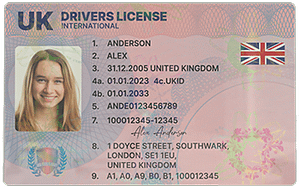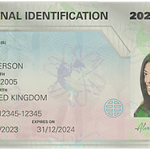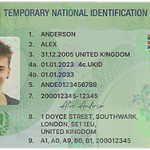Identity cards are crucial documents that serve as proof of a person’s identity in various aspects of life, such as accessing services, conducting financial transactions, and traveling. However, the existence of fake ID cards is a persistent problem. Proving that an ID card is fake can be a complex and challenging task, fraught with several difficulties.
Technical Sophistication of Fake ID Cards
One of the primary challenges is the increasing technical sophistication of fake ID – making techniques. Counterfeiters have access to advanced printing technologies, such as high – resolution printers, laminators, and specialized software. They can replicate many of the visual features of a genuine ID card, including holograms, watermarks, and microprinting. For example, holograms on some real ID cards are designed to provide a level of security, but counterfeiters have found ways to create convincing replicas. These fake holograms may look similar to the real ones at first glance, making it difficult for the untrained eye to detect the difference. Watermarks, which are often embedded in the card’s material, can also be imitated. Some counterfeiters use image – editing software to create what appears to be a watermark when in fact it is just a printed image on the surface of the card.

Microprinting, another security feature on many ID cards, involves printing very small text or patterns that are difficult to reproduce accurately. Nevertheless, with high – quality printing equipment, counterfeiters can come close to replicating this feature as well. This makes it essential for those tasked with verifying ID cards to have specialized equipment and training to detect these subtle differences.
Verification Process Complexity
The verification process itself is complex. Different types of ID cards, such as driver’s licenses, passports, and national identity cards, have different security features and verification methods. For example, a driver’s license may have specific magnetic stripe or barcode data that needs to be cross – checked with a central database. However, accessing and validating this data may not always be straightforward. There could be issues with the database connectivity, such as network outages or slow response times. In some cases, the database may not be up – to – date, leading to incorrect verification results.
Passports, on the other hand, have a wide range of security features, including biometric data (fingerprints, facial recognition) in addition to the traditional visual elements. Verifying biometric data requires specialized equipment and software. If the biometric data on the passport does not match the data in the official database, it could be due to a number of reasons, such as poor quality data capture during the enrollment process or a technical glitch in the verification system. Moreover, different countries may have different standards and procedures for passport verification, adding another layer of complexity when dealing with international ID cards.
Legal and Regulatory Hurdles
Proving that an ID card is fake also involves legal and regulatory hurdles. There are strict rules and procedures regarding the handling and verification of ID cards. For example, in many jurisdictions, there are privacy laws that govern the collection, storage, and use of personal data on ID cards. When trying to verify an ID card, organizations and individuals need to ensure that they are complying with these laws. This can limit the amount of data that can be accessed or the methods that can be used for verification.
Additionally, the legal definition of a fake ID card may vary from place to place. Some regions may have specific criteria for what constitutes a counterfeit ID, such as the presence of unauthorized alterations or the use of non – approved materials. Prosecuting individuals for using or producing fake ID cards requires clear evidence that meets these legal standards. Gathering such evidence can be challenging, especially when dealing with sophisticated counterfeits that may not have obvious signs of forgery.
Human Error and Subjectivity
Human error and subjectivity play a significant role in the process of proving an ID card is fake. Even with the best training, verification officers may make mistakes. For example, they may misinterpret a security feature or fail to notice a subtle difference due to inattention or lack of experience. Visual inspection of an ID card can be subjective, as different people may have different opinions on what constitutes a normal or abnormal feature. For instance, a small discoloration on an ID card may be seen as a manufacturing defect by one person, while another may suspect it as a sign of forgery.
Moreover, in high – pressure or busy environments, such as airport security checkpoints or large – scale events, verification officers may be more prone to making errors. They may not have enough time to conduct a thorough inspection of each ID card, leading to potential false negatives or false positives. False negatives occur when a fake ID card is not detected, while false positives happen when a genuine ID card is wrongly flagged as fake.
Common Problems and Solutions
Problem 1: Difficulty in Detecting Subtle Visual Differences
Solution: Provide comprehensive training to verification officers on the detailed visual features of genuine ID cards. This training should include hands – on practice with both real and fake ID samples. Use magnifying devices and other visual inspection tools to help officers spot microprinting, hologram details, and other small but crucial features. Regularly update the training materials to keep up with the latest counterfeiting techniques and new security features on ID cards.
Problem 2: Database – Related Verification Issues
Solution: Ensure reliable network connectivity for database access during ID verification. Implement backup systems to prevent data access disruptions in case of network outages. Regularly update the central databases with the most current ID card information. Develop algorithms and software that can handle data inconsistencies and provide more accurate verification results. For example, if there are minor discrepancies in the data, the system can be programmed to prompt for additional verification steps rather than immediately flagging the ID as fake.
Problem 3: Complying with Legal and Regulatory Requirements
Solution: Establish clear guidelines and procedures for ID card verification that are in line with local and international laws. Provide legal training to verification personnel so that they understand their rights and obligations when handling personal data. Work closely with legal experts to ensure that any evidence gathered during the verification process is admissible in court. Develop privacy – compliant data management systems that protect the personal information of ID card holders while still enabling effective verification.
Problem 4: Human Error in Visual Inspection
Solution: Implement quality control measures to review the work of verification officers. This can include random audits of verified ID cards to check for accuracy. Provide incentives for officers to maintain high – quality verification standards, such as performance – based bonuses. Use automated verification systems as a supplement to human inspection. For example, machines can be used to quickly scan ID cards for basic security features, and then human officers can conduct more in – depth inspections on flagged cards.
Problem 5: Subjectivity in ID Card Evaluation
Solution: Develop standardized evaluation criteria for ID card features. Create a checklist of specific features and their expected characteristics so that verification officers have a clear reference when making judgments. Encourage officers to document their reasons for suspecting an ID card as fake or genuine. This documentation can be used for further review and training purposes. Additionally, establish a second – opinion process, where if an officer is unsure about an ID card’s authenticity, another experienced officer or a specialist can be consulted for a more objective evaluation.



